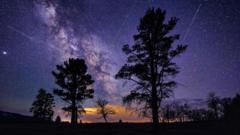Lyrid meteor shower set to peak on Tuesday

Light trails from streaking Lyrid meteors in US, in April 2020
Darren Bett
Lead Weather Presenter
Shireen Jordan
BBC Weather
We have had some wonderful celestial events this spring with two consecutive nights of Northern Lights sightings over the last week and there is more to come with the Lyrid meteor shower.
It happens every year during mid to late April, visible as short-lived streaks of light in the sky.
This year the Lyrids will be active until 25 April and will peak on Tuesday.

Five years ago both the Northern Lights and Lyrid meteors were visible in the sky over Howick, Northumberland
What is a meteor shower?
Meteor showers happen when dust from a passing comet or asteroid passes through the Earth’s atmosphere. The tiny particles – roughly the size of a grain of sand – vaporise creating visible streaks of light.
As the Earth passes through the densest part of the dust stream more meteors are visible. For the Lyrids a maximum of around 18 meteors an hour are likely.
In some years, however, this can intensify and there can be 100 meteors every hour, but it is very difficult to know when this will happen.
Observations of the Lyrids date back around 2,700 years meaning it is one of the oldest-known meteor showers.
The fireballs are created by debris from Comet Thatcher, which takes more than 400 years to orbit the Sun and was discovered in 1861 by A. E. Thatcher.
They are named after the constellation Lyra and the radiant position, which is where the meteors appear to emanate from, is south-west of the star Vega.
Lyrids meteor shower 2025
How can I see them?
Generally speaking, the best time to see the shower is in the early morning of the peak day.
This year’s Lyrids coincide with the Moon’s last quarter which should mean good viewing conditions overall – but it is best to avoid times when the moon is in the sky.
The best time to spot the meteors will be when the skies are at their darkest and clearest so stay away from light pollution if you can.
It will take around 15-20 minutes for your eyes to adapt to the darkness so be patient.
Wrap up warm and try not to crane your neck – perhaps sit back in a deckchair and make sure you take regular breaks.

The Lyrids are visible around the world. This was the meteor shower over Schermbeck, Germany, in 2020
Will the skies be clear?
The weather over the next few days looks very mixed with low pressure close to the UK.
Overnight Easter Sunday into Easter Monday, low pressure will bring cloud and rain to many areas, which will obscure the view at times. The best chance of clearer interludes will be in the east.
Monday night will bring better prospects of clearer skies more widely across the UK.
The exact hour-by-hour forecast will vary depending on where you are, so best to check your local forecast – as well as the sunrise and sunset times – on the BBC Weather website or app.







